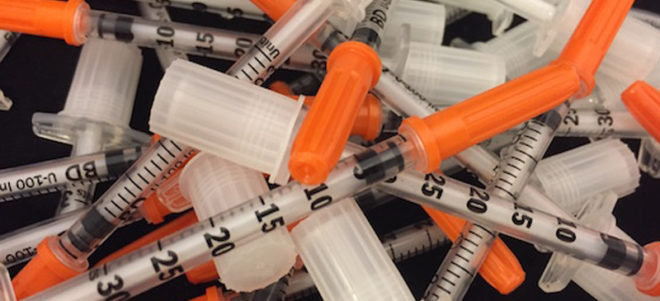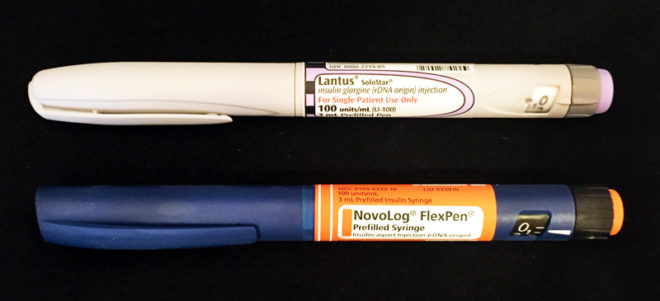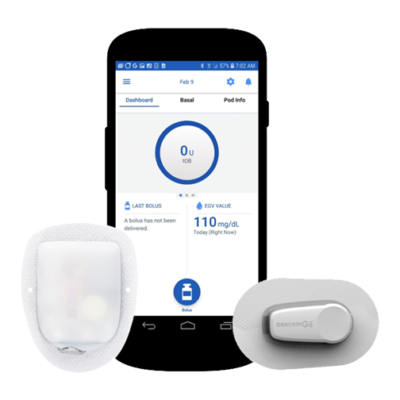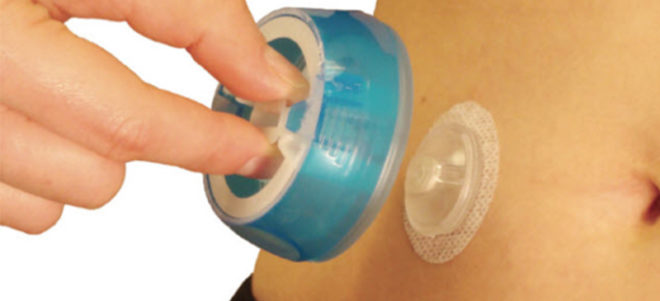Insulin Delivery
When people eat sugars and starches, the body breaks them down into glucose with the help of insulin, the hormone that gets glucose from the bloodstream into the cells of the body to be used as energy. However, for people with type 1 diabetes and in some cases those with type 2 diabetes, this process cannot happen without manually giving insulin subcutaneously, since the pancreas, (the organ that produces insulin) stops doing so. Insulin must be injected and infused into the layers of fat under the skin.
There are quite a few different ways to deliver insulin, each with pros and cons, and it is up to the person with type 1 and his or her doctor to decide what will work best.

Syringes
How it works:
- Before anything, it is important to wash your hands and clean the skin with alcohol.
- You’ll first need to uncap the needle of the syringe.
- Pull the plunger to fill the syringe with air.
- Insert the needle of the syringe into the vial of insulin.
- Draw the plunger until the appropriate dose of insulin is inside the syringe barrel.
- Holding the syringe upright, tap the syringe to release any air bubbles that may have collected in the barrel.
- Next, insert the needle into the skin using your index finger or thumb and push the plunger down until all the insulin has emptied from the barrel.
- Re-cap needle and dispose of in a secure sharps container.
- How to Give Yourself an Insulin Shot (with an animated video)
- How to Give Someone an Insulin Shot (with an animated video)
How long it lasts
For one-time use and should be disposed of immediately following use into a sharps container
Cost
$10-15 per box of 100. Price may vary based on insurance coverage.
Pros
You don’t have the burden of a device attached to you.
Cons
You have to carry syringe supplies and vials of insulin with you, and make sure you don’t forget any of the steps involved in drawing up a dose of insulin. (A vial of insulin at room temperature should only be used for 28 days from opening, and must be disposed of after this time, even if there is insulin left over.) This can result in wasted insulin.

Pens
How it works
- Prepare and clean the skin with alcohol wipes.
- Uncap the pen.
- Attach the pen needle.
- Dial up the dose using the dial on the end of the pen opposite the needle.
- If using a pen for the first time, prepare the pen by first drawing in a very small dose of insulin and then pushing it into the air.
- Insert needle into skin and push in the end to administer insulin.
- When done, remove pen needle and dispose of in a secure sharps container.
How long it lasts
Some pens are disposable, others have replaceable cartridges of insulin that can be inserted into the pen. Once opened and stored at room temperature a pen is good for 28 days before it must be replaced.
Cost
Varies drastically depending on the insulin you are using, the pen brand and your insurance; $20-70 per box of 100 disposable needles (costs varies depending on gauge of needle).
Pros
Their small size and likeness to ink pens makes insulin pens a convenient and discreet way of carrying insulin. They’re often less painful than syringes because of smaller needles.
Cons
The pen needs to remain in the skin slightly longer than a traditional syringe injection, about five seconds after the plunger has been released. Pens can also be easy to lose or forget.

Pumps
How it works
- Pumps are small, computerized devices that deliver fast or short-acting insulin 24 hours a day through a catheter placed under the skin.
- They deliver insulin consistently over a 24 hour period in the form of basel doses, and after eating or to correct a high blood glucose (BG) you “bolus” to administer the insulin.
- Many pumps have algorithms so you can put your Insulin:Carb ratio, correction factor, target BG levels and insulin sensitivity into the pump.
- The pump will then help you calculate how much insulin to administer based on your blood sugar or carb count. However, you can also “bolus” manually without the use of the pump calculator.
- Some pumps are now integrated with CGM technology, though this is not yet as common.
How long it lasts
The pump holds a small cartridge of insulin that usually needs to be replaced every 3 days depending on the individuals insulin needs. The pump site, aka the ‘catheter’, must be changed every three days to avoid bruising, insulin buildup and scar tissue. The actual pump devices typically last four to five years, but many will still work after their warranty has expired.
Cost
$4,500-6,500 without insurance.
Pros
- You don’t have to individually stick yourself with a needle every time you need to inject insulin, instead you only have to use a needle once every three days to insert the catheter.
- Pumps deliver insulin more accurately than injections, as they have smaller dose increments.
Cons
- Pumps can be expensive, even with insurance.
- The idea of wearing a device 24/7 can be off-putting for some people, especially if it is a pump with a cord.
- Pump sites can be ripped out accidentally, and there is always the possibility of the pump malfunctioning.

Pod Therapy
How it works
- Pod therapy by Insulet offers two versions: the Omnipod 5 ( a closed-loop system) and the Omnipod DASH. With many similarities, both are a tubeless, wearable, waterproof insulin pump that can hold up to 200 units of insulin and delivers 72 hours of continuous insulin therapy through customizable basal rates and bolus amounts. Basal dosages keep your blood sugar stable over time and “bolus” insulin dosages are given for meals or to correct high blood sugar.
- Omnipod 5 is an automated insulin delivery system (AIDs) that integrates with your Dexcom G6 continuous glucose monitor to automatically adjust insulin doses based on real-time blood glucose data.
- Pod therapy by Insulet’s Omnipod DASH Insulin Management System is a tubeless, wearable, waterproof insulin pump that can hold up to 200 units of insulin and delivers 72 hours of continuous insulin therapy through customizable basal rates and bolus amounts. Basal dosages keep your blood sugar stable over time and “bolus” insulin dosages are given for meals or to correct high blood sugar.
- Omnipod DASH users get a personal diabetes manager (PDM) to wirelessly control the Pod.
- Complimentary iPhone widgets give users the ability to see their CGM data and insulin delivery information together on a single screen.
- Two iOS mobile apps — Omnipod DISPLAY and Omnipod VIEW—allows users to see their PDM information on their smartphone and share therapy status with up to 12 friends/family members.
- Users get access to a CalorieKing food library with carbohydrate content for over 80,000 foods.
How long it lasts
The pump holds a small cartridge of insulin that usually needs to be replaced every three days to prevent bruising, insulin buildup, scar tissue and possible infections.
Cost
Omnipod can be as low as a $20 co-pay through the pharmacy, which is another benefit of this product.
Pros
- The Omnipod 5 automatically adjusts insulin doses for you based on blood glucose data from your Dexcom G6 which requires less mental effort from you to stay within your target blood glucose range.
- Both types of Omnipod systems have customizable basal insulin profile and bolus calculator. This means you can customize how much insulin you need throughout the day based on insulin sensitivity. With the bolus calculator, you can determine how much insulin you need based on the number of carbs in your meal.
- While traditional pumps have infusion set tubing that connects the pump to the body, however, the Omnipod Insulin Delivery System, does not have tubing and adheres to the body anywhere an injection would be administered.
- With the Omnipod Delivery System’s auto cannula insertion, you don’t need to see or handle a needle when changing your pump site.
- More accurate insulin injections. Insulin can also be injected in smaller dose increments.
- Improved glucose management compared with injections.
- Easier to dose insulin for meals and exercise.
- Decreased risk of hypoglycemia and diabetes-related complications.
- Can adjust insulin dosages as you see fit.
Cons
- The idea of wearing a device 24/7 can be off-putting for some people.
- There is always the possibility of the pump malfunctioning.

Inhaled insulin
How it works:
- Inhaled insulin is used as a mealtime insulin, designed specifically to lower blood sugar spikes that can happen after you eat.
- It works faster than traditional injected insulins.
- Using an inhaler similar to those used for asthma, you breathe a fine insulin powder into your lungs.
- The insulin then enters your blood through small blood vessels.
How long it lasts
Once opened, the inhalers can be used for up to 15 days.
Cost
Afrezza, currently the only inhaled insulin approved by the Food and Drug Administration, may be covered by your insurance. Check with your provider for exact costs. Afrezza’s website offers an option to sign up for a $0 co-pay on your first prescription. There is also a saving program.
Pros
- No invasive needle injections means no pain.
- Because it peaks in 30 minutes, you don’t have to wait as long to eat and are less likely to to stack insulin in anticipation.
- A recent STAT study also cited benefits of reduced incident of hypoglycemia.
Cons
- You’ll still need to take long-acting insulin to monitor your blood sugar.
- Side effects may include a cough and throat irritation.
- Not recommended for patients with asthma or who smoke.
- It is not known if Afrezza is safe and effective in children under 18.

Medtronic i-Port
How it works:
- The i-Port is a small device intended for people who use a syringe or pen to deliver insulin.
- It combines an injection port and inserter to make for a quick insertion of the device, which leaves a small soft plastic cannula under the skin.
- Syringes or pens are then inserted into the port every time an injection is needed, which drastically reduces the amount of pokes per day.
- Similar to a pump site, the i-Port must be changed every three days.
How long it lasts
The i-Port can be worn for up to three days.
Cost
$96 per box of 10
Pros
You can wear it while you shower, bathe and exercise. It drastically reduces the amount of needle pokes into the skin, allowing for less pain. It is great for kids or those not comfortable with needles.
Cons
Infection, irritation or inflammation can result from improper cleaning of the skin prior to application. Must be changed every three days.
Disposable Insulin Patch (CeQur Simplicity)
How it works
- CeQur Simplicity is an ultra-simple insulin patch delivery device for your mealtime insulin needs.
- CeQur Simplicity doses 2 units of insulin with every squeeze of the buttons on either side of the device.
- You can fill your CeQur Simplicity with between 100 to 200 units of rapid-acting insulin, like Novolog or Humalog.
- Inserting CeQur is quick and simple, done at home.
- A small, flexible cannula sits in your subcutaneous flesh (body fat) and delivers insulin when dosed.
- CeQur Simplicity can be worn in a variety of locations on your body as long as you can reach it easily to press the button for dosing insulin.
- CeQur Simplicity is for people with type 1 and type 2 diabetes who need mealtime insulin.
How long it lasts
- Three days
Cost
- CeQur Simplicity is covered on most commercial and Medicare Part D insurance plans as a pharmacy benefit. Where covered, most patients have a co-pay of $50 or less a month. Individual plans and pharmacy benefits may vary by patient.
Pros
- Easy to insert and set-up
- Water-resistant
- Discrete
- Does not require batteries
- Very easy to manage
- No additional tech devices to administer insulin
- Can be used in addition to your basal insulin therapy regimen
Cons
- It must be worn on areas of the body you can easily reach in order to dose insulin at meals.
- If you need basal (background) insulin, you’ll still need to take it in addition to wearing the CeQur Simplicity.
- Like any device, it can potentially malfunction, requiring you to keep an injection insulin delivery method nearby.
More on Tools and How To and Understanding Your A1C






